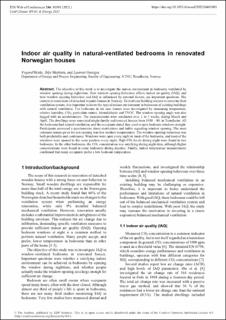| dc.contributor.author | Heide, Vegard | |
| dc.contributor.author | Skyttern, Silje | |
| dc.contributor.author | Georges, Laurent | |
| dc.date.accessioned | 2022-10-31T09:48:31Z | |
| dc.date.available | 2022-10-31T09:48:31Z | |
| dc.date.created | 2021-11-12T14:51:18Z | |
| dc.date.issued | 2021 | |
| dc.identifier.citation | E3S Web of Conferences. 2021, 246, . | en_US |
| dc.identifier.issn | 2267-1242 | |
| dc.identifier.uri | https://hdl.handle.net/11250/3029055 | |
| dc.description.abstract | The objective of this work is to investigate the indoor environment in bedrooms ventilated by window opening during night-time. How window opening behaviour affects indoor air quality (IAQ), and how window opening behaviour and IAQ is influenced by external factors, are important questions. The context is renovation of detached wooden houses in Norway. To motivate building owners to renovate their ventilation system, it is important to know the typical indoor environment in bedrooms of existing buildings with natural ventilation. Ten bedrooms in six case houses were investigated by measuring temperature, relative humidity, CO2, particulate matter, formaldehyde and TVOC. The window opening angle was also logged with an accelerometer. The measurements were conducted over 2 to 3 weeks, during March and April. The dwellings were renovated single-family and terraced houses from 1950 – 80, in Trondheim. All the bedrooms had natural ventilation, and the occupants stated they used to open bedroom windows at night. Participants answered a questionnaire about motivations and habits regarding window opening. The most common reason given for not opening was low outdoor temperatures. The window opening behaviour was both predictable and continuous. Windows were open every night in most of the bedrooms, and most of the windows were opened to the same position every night. High CO2 levels during night were found in two bedrooms. In the other bedrooms, the CO2 concentration was satisfying during night-time, although higher concentrations were found in some bedrooms during daytime. Finally, indoor temperature measurements confirmed that many occupants prefer a low bedroom temperature. | en_US |
| dc.language.iso | eng | en_US |
| dc.publisher | EDP Sciences | en_US |
| dc.rights | Navngivelse 4.0 Internasjonal | * |
| dc.rights.uri | http://creativecommons.org/licenses/by/4.0/deed.no | * |
| dc.title | Indoor air quality in natural-ventilated bedrooms in renovated Norwegian houses | en_US |
| dc.title.alternative | Indoor air quality in natural-ventilated bedrooms in renovated Norwegian houses | en_US |
| dc.type | Peer reviewed | en_US |
| dc.type | Journal article | en_US |
| dc.description.version | publishedVersion | en_US |
| dc.source.pagenumber | 9 | en_US |
| dc.source.volume | 246 | en_US |
| dc.source.journal | E3S Web of Conferences | en_US |
| dc.identifier.doi | 10.1051/e3sconf/202124601001 | |
| dc.identifier.cristin | 1954154 | |
| dc.relation.project | Norges forskningsråd: 280956 | en_US |
| cristin.ispublished | true | |
| cristin.fulltext | original | |
| cristin.qualitycode | 1 | |

